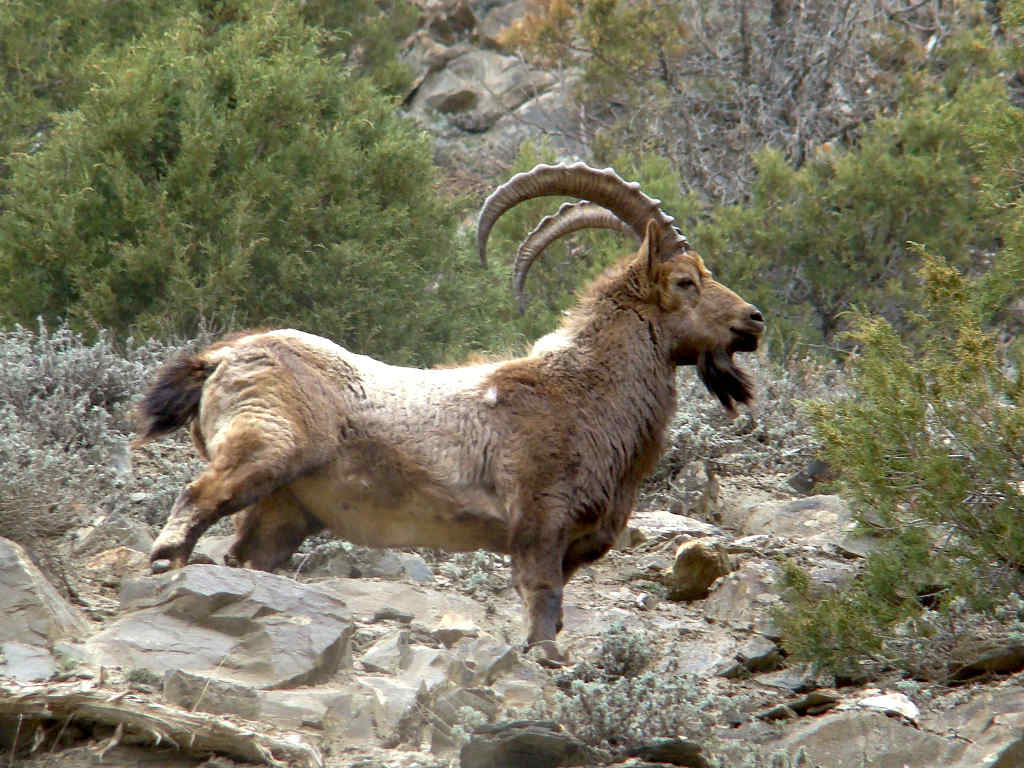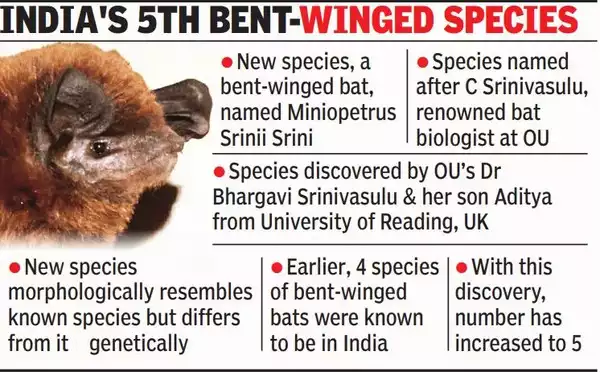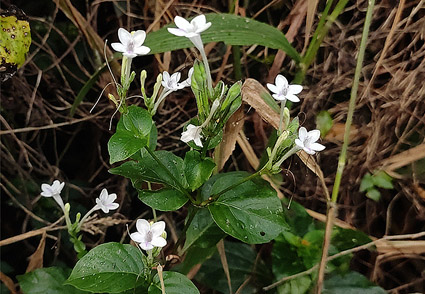Biodiversity & Environment
New Species of Plants and Animals Discovered
- 02 Jul 2024
- 7 min read
For Prelims: Zoological Survey of India, Botanical Survey of India, Himalayan Ibex, Miniopterus Srinii, Western Ghats
For Mains: India's Faunal and Floral Diversity, Environmental Conservation, Environmental Pollution and Degradation
Why in News?
Recently, in 2023, India witnessed significant advancements in its Biodiversity knowledge with the addition of numerous animal and plant species to its faunal and floral databases.
- The findings were compiled in two publications: "Animal Discoveries 2023" by the Zoological Survey of India (ZSI) and "Plant Discoveries 2023" by the Botanical Survey of India (BSI).
Note
- India is a megadiverse nation, with around 7-8% of the world's documented species and 4 of the 34 globally recognized biodiversity hotspots.
What are the Major Additions in India’s Faunal and Floral Database?
- Faunal Discoveries:
- India added 641 new species to the fauna database in 2023, including 442 entirely new species and 199 species which have been newly recorded in the country.
- Significant Animal Discoveries Include:
- Capra Himalayensis, which proves that the Himalayan Ibex, distributed in the trans-Himalayan ranges of Jammu and Kashmir, Ladakh and Himachal Pradesh, is a distinct species from the Siberian Ibex.

- Miniopterus Srinii, a new species of bent-winged bat, was also found in the Kodagu district of Karnataka.

- Kerala recorded the highest number of animal discoveries, with 74 completely new species and 27 new records. It was followed by West Bengal (72 new species), and Tamil Nadu (64).
- Invertebrates accounted for the majority of new faunal discoveries with 564 new species, while vertebrates constituted 77 species.
- Insects (with 369 species) comprised the largest group among invertebrates, and fish (with 47 species) dominated among vertebrates.
- It was followed by Reptiles, Amphibia, Mammals and least with Aves.
- Capra Himalayensis, which proves that the Himalayan Ibex, distributed in the trans-Himalayan ranges of Jammu and Kashmir, Ladakh and Himachal Pradesh, is a distinct species from the Siberian Ibex.
Note
- Vertebrates: Animals with a backbone/spine, well-developed internal skeleton, distinct head with a brain, bilateral symmetry, and complex internal organs. Examples: mammals, birds, and reptiles.
- Invertebrates: Animals without a backbone/spine, typically have an exoskeleton or soft body varying body plans, and simpler internal organ systems. Examples: insects, worms, jellyfish.
- Floral Discoveries: In 2023, India also added 339 taxa to its plant database, including 326 species, and 13 infraspecific taxa. Of these, 171 taxa are new and 168 taxa are new distributional records from India.
- Taxa can refer to a sub-species or variety of plant species.
- West Bengal (52 new taxa) recorded the highest number of new plant discoveries, followed by Kerala and Uttarakhand.
- The discovery includes 106 angiosperms, 2 Pteridophytes, 16 Bryophytes, 44 lichens, 111 fungi, 50 algae and 10 microbes.
- New discoveries include wild relatives of many potential horticultural, agricultural, medicinal, and ornamental plants like begonias, impatiens, legumes, zingibers, and orchids.
- Western Ghats and North Eastern Regions were the hotspot regions contributing to 14% of total discoveries,
- New Plant Discoveries:
Animal Taxonomy Summit-2024
- The Zoological Survey of India (ZSI) organised the Animal Taxonomy Summit 2024 from June 30th to July 3rd 2024, in Kolkata, marking the institution's 109th anniversary.
- This summit brought together approximately 350 delegates from four countries, including renowned participants from the Natural History Museum in London.
- Over the three-day event, experts engaged in in-depth discussions across three broad themes:
- Taxonomy, Systematics, and Evolution
-
Ecology and Animal Behaviour
-
Biodiversity and Conservation
- The summit's deliberations aimed to advance the understanding and application of these crucial fields.
- Launch of “Fauna of India Checklist Portal”:
- It was launched at this summit as a first-of-its-kind global portal documenting all animal species in India.
- The 'Fauna of India Checklist Portal' is a first-of-its-kind exhaustive checklist comprising 121 checklists covering 36 phyla and 1,04,561 animal species found across India.
- This includes information on endemic, threatened and scheduled species accounting for 6.6% of global faunal diversity.
Zoological Survey of India
- ZSI is also a subordinate organization of the MoEFCC and was established in 1916 as a national center for the faunistic survey and exploration of the resources leading to the advancement of knowledge on the exceptionally rich faunal diversity of the country.
- It has its headquarters at Kolkata and 16 regional stations located in different geographic locations of the country.
Botanical Survey of India
- It was established in 1890 as an apex research organisation under the Ministry of Environment and Forests (MoEFCC) for carrying out taxonomic and floristic studies on wild plant resources of the country.
- It has 9 regional circles situated at different regions of the country. However the headquarter is in Kolkata, West Bengal.
Read more: Additions to India's Faunal and Floral Databases
|
Drishti Mains Question: Discuss the various threats to biodiversity and examine the role of international agreements and national policies in promoting biodiversity conservation in India. |
UPSC Civil Services Examination, Previous Year Questions (PYQs)
Prelims
Q. Recently, our scientists have discovered a new and distinct species of banana plant which attains a height of about 11 meters and has orange coloured fruit pulp. In which part of India has it been discovered? (2016)
(a) Andaman Islands
(b) Anaimalai Forests
(c) Maikala Hills
(d) Tropical rain forests of northeast
Ans: (a)
Q. Biodiversity forms the basis for human existence in the following ways: (2011)
- Soil formation
- Prevention of soil erosion
- Recycling of waste
- Pollination of crops
Select the correct answer using the codes given below:
(a) 1, 2 and 3 only
(b) 2, 3 and 4 only
(c) 1 and 4 only
(d) 1, 2, 3 and 4
Ans: (d)
Mains
Q. How does biodiversity vary in India? How is the Biological Diversity Act,2002 helpful in the conservation of flora and fauna? (2018)






